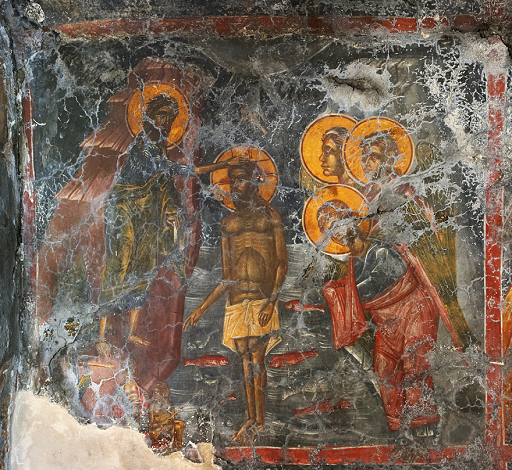5 Identify the iconography
This final wall painting is situated on the north wall in the church of Saint George, in the village of Kavousi, in the prefecture of Ierapetra, on the island of Crete. Looking back to Week 1, Section 3.4, this church was decorated when the island was under Venetian rule.
Activity 3 Identify the iconography
Take a close look at Figure 14.

- a.Can you identify the scene?
- b.Which details are not included in the Gospel narrative?
Like in Activity 1, you might use Appendix 2 [Tip: hold Ctrl and click a link to open it in a new tab. (Hide tip)] and kingjamesbibleonline.org (or a search engine) to locate the Gospel passages that narrate this event. This will help you to compare the words and the visual representation.
Discussion
- a.This is the Baptism of Christ, a very important Sacrament in Orthodox Church, which initiates the faithful to Christianity.
- b.The attending angels, usually depicted in the Baptism scene standing on the left bank of the river Jordan, as seen here, are not mentioned in the Gospel narrative. It is highly likely that their introduction in the scene is both an indication that the Heaven above is also witnessing this ritual (i.e., a visualisation of the voice of God) and a reflection of the actual ritual of the Baptism (i.e., attendants of the ritual and one of them with covered hands, waiting to receive the newly baptised).
It is important to remember that details that have found their way into Byzantine iconography and are not included in the Gospel narratives reflect re-enaction of the ritual in real life, as the faithful would have witnessed many a time by attending the liturgy and partaking in the Sacraments of the Church.
Finally (looking back to Week 1, Section 3.2), this painting is part of the second zone of a church’s hierarchical construction, as it represents a scene of the life of Christ.
